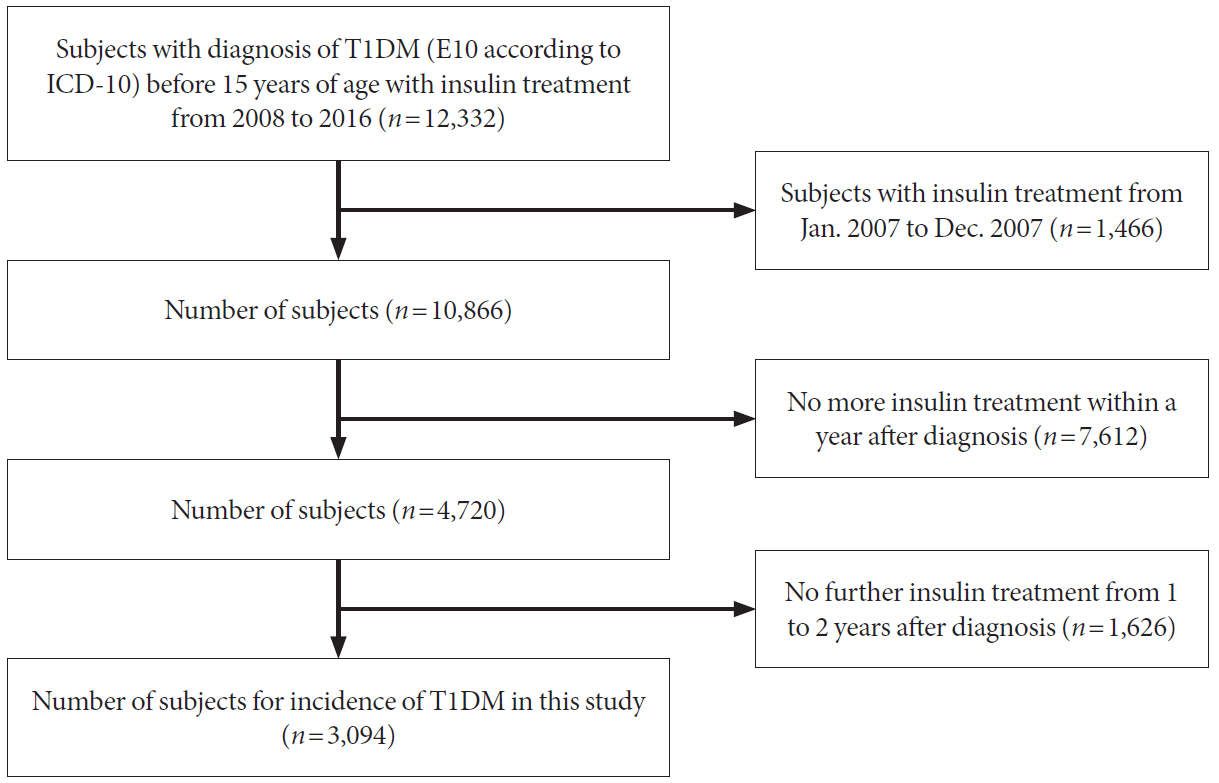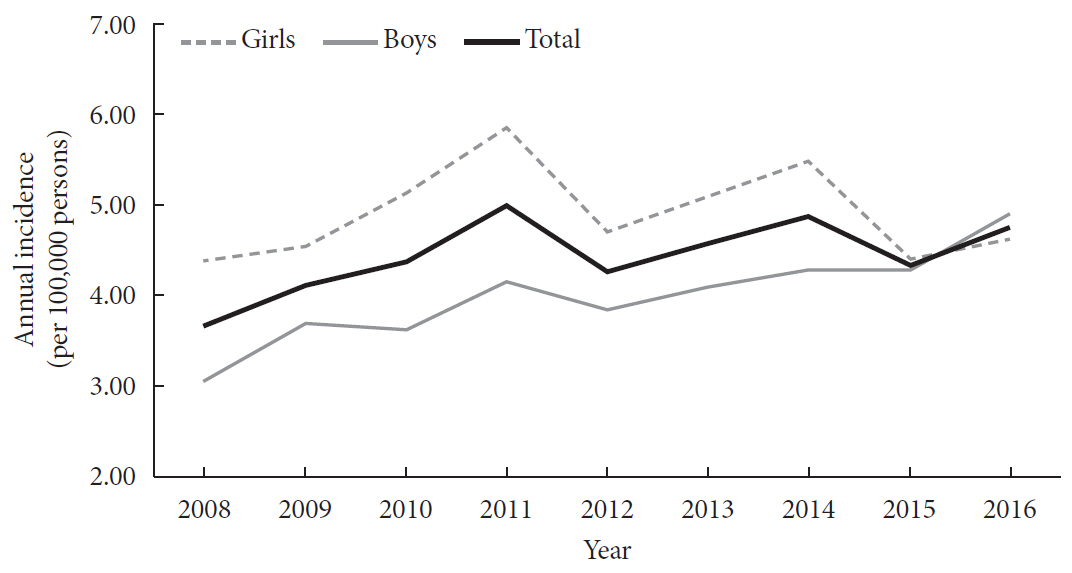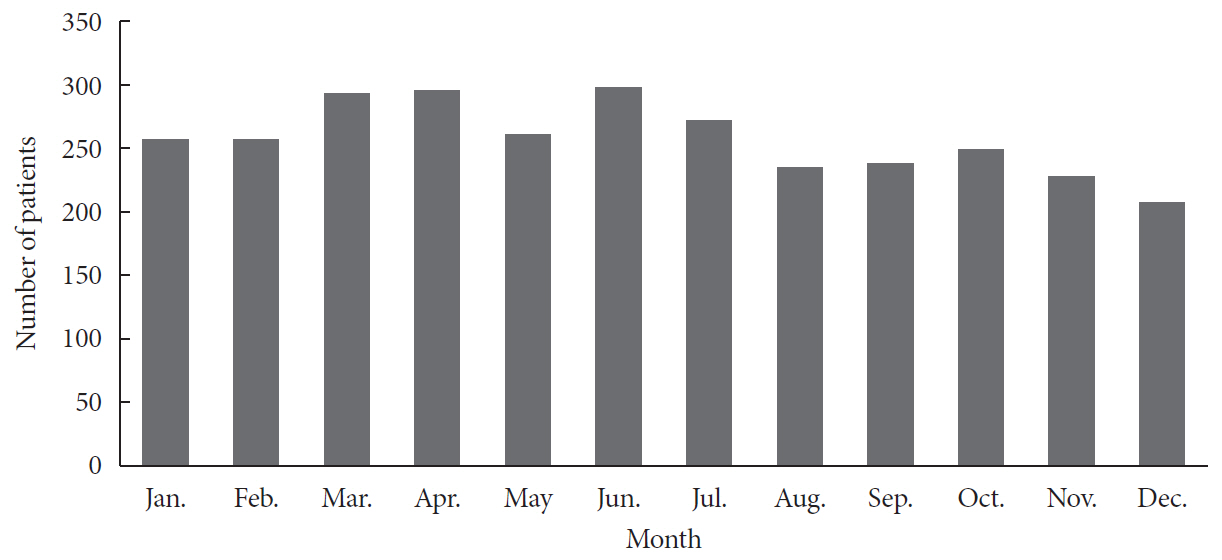Incidence and Prevalence of Type 1 Diabetes Mellitus among Korean Children and Adolescents between 2007 and 2017: An Epidemiologic Study Based on a National Database
- Affiliations
-
- 1Department of Pediatrics, Endocrine Research Institute, Severance Children’s Hospital, Yonsei University College of Medicine, Seoul, Korea
- 2Korean Health Insurance Review and Assessment Service, Seoul, Korea
- KMID: 2513050
- DOI: http://doi.org/10.4093/dmj.2020.0212
Abstract
- Background
The incidence of type 1 diabetes mellitus (T1DM) among children is high in Europe and the USA and relatively low in Asia, including Korea. The present study aimed to investigate the incidence and prevalence of childhood-onset T1DM in Korea and examine trends in incidence.
Methods
This study was conducted using the national registry data provided by the Health Insurance Review and Assessment Service in Korea from 2007 to 2017. We included children aged 0 to 14 years who were newly registered with a T1DM diagnosis each year (code E10).
Results
A total of 29,013 children were registered. The overall incidence of T1DM was 4.45 per 100,000 persons (girls, 4.93; boys, 4.01). The overall incidence of childhood-onset T1DM in Korea increased from 3.70 in 2008 to 4.77 in 2016 (P=0.002). The incidence of T1DM increased from 3.07 in 2008 to 4.89 in 2016 (P<0.001) among boys. Although the incidence of the disease increased significantly among boys aged 5–9 and 10–14 years, it remained constant among girls (4.39 in 2008, 4.64 in 2016). The overall prevalence of childhood-onset T1DM in Korea increased from 32.85 in 2007 to 41.03 per 100,000 persons in 2017 (girls, 35.54 to 43.88; boys, 32.85 to 41.03).
Conclusion
We calculated relatively accurate incidence and prevalence of childhood-onset T1DM from a nation-based registry. The incidence increased by 3% to 4% every year from 2007 to 2017. The increasing trend is noteworthy compared with previous reports.
Keyword
Figure
Cited by 8 articles
-
Age at Diagnosis and the Risk of Diabetic Nephropathy in Young Patients with Type 1 Diabetes Mellitus (
Diabetes Metab J 2021;45:46-54)
Ye Seul Yang, Tae Seo Sohn
Diabetes Metab J. 2021;45(2):277-278. doi: 10.4093/dmj.2021.0028.Diabetes in Adolescence, Appropriate Transition to Adult Clinic
Jieun Lee, Jae Hyun Kim
J Korean Diabetes. 2021;22(2):77-84. doi: 10.4093/jkd.2021.22.2.77.Current Advances of Artificial Pancreas Systems: A Comprehensive Review of the Clinical Evidence
Sun Joon Moon, Inha Jung, Cheol-Young Park
Diabetes Metab J. 2021;45(6):813-839. doi: 10.4093/dmj.2021.0177.A Position Statement of the Utilization and Support Status of Continuous Glucose Monitoring in Korea
Won Jun Kim, Jae Hyun Kim, Hye Jin Yoo, Jang Won Son, Ah Reum Khang, Su Kyoung Kwon, Ji Hye Kim, Tae Ho Kim, Ohk Hyun Ryu, Kyeong Hye Park, Sun Ok Song, Kang-Woo Lee, Woo Je Lee, Jung Hwa Jung, Ho-Chan Cho, Min Jeong Gu, Jeongrim Lee, Dal Lae Ju, Yeon Hee Lee, Eun Kyung Kim, Young Sil Eom, Sung Hoon Yu, Chong Hwa Kim
J Korean Diabetes. 2021;22(4):225-237. doi: 10.4093/jkd.2021.22.4.225.History of insulin treatment of pediatric patients with diabetes in Korea
Jae Hyun Kim, Choong Ho Shin, Sei Won Yang
Ann Pediatr Endocrinol Metab. 2021;26(4):237-241. doi: 10.6065/apem.2142242.121.Do Type 1 and Type 2 Diabetes Have the Same Vascular Complications?
Yun Kyung Cho
J Korean Diabetes. 2024;25(2):62-68. doi: 10.4093/jkd.2024.25.2.62.Management Strategies for Children and Adolescents with Diabetes Mellitus
Ja Hyang Cho
J Korean Diabetes. 2024;25(3):145-149. doi: 10.4093/jkd.2024.25.3.145.Changes in the Epidemiological Landscape of Diabetes in South Korea: Trends in Prevalence, Incidence, and Healthcare Expenditures
Kyoung Hwa Ha, Dae Jung Kim
Endocrinol Metab. 2024;39(5):669-677. doi: 10.3803/EnM.2024.2073.
Reference
-
1. Onda Y, Sugihara S, Ogata T, Yokoya S, Yokoyama T, Tajima N, et al. Incidence and prevalence of childhood-onset type 1 diabetes in Japan: the T1D study. Diabet Med. 2017; 34:909–15.
Article2. DIAMOND Project Group. Incidence and trends of childhood type 1 diabetes worldwide 1990-1999. Diabet Med. 2006; 23:857–66.3. Patterson CC, Dahlquist GG, Gyurus E, Green A, Soltesz G; EURODIAB Study Group. Incidence trends for childhood type 1 diabetes in Europe during 1989-2003 and predicted new cases 2005-20: a multicentre prospective registration study. Lancet. 2009; 373:2027–33.
Article4. Aminzadeh M, Navidi N, Valavi E, Aletayeb SMH. Childhood onset type 1 diabetes at a tertiary hospital in south-western Iran during 2000-2015: rapid increase in admissions and high prevalence of DKA at diagnosis. Prim Care Diabetes. 2019; 13:43–8.
Article5. Viswanathan V, Sathyamurthy S. Global increase in the prevalence of diabetes with special reference to the Middle East and Asia. Diabetes Technol Ther. 2015; 17:676–8.
Article6. Harjutsalo V, Sund R, Knip M, Groop PH. Incidence of type 1 diabetes in Finland. JAMA. 2013; 310:427–8.
Article7. Berhan Y, Waernbaum I, Lind T, Mollsten A, Dahlquist G; Swedish Childhood Diabetes Study Group. Thirty years of prospective nationwide incidence of childhood type 1 diabetes: the accelerating increase by time tends to level off in Sweden. Diabetes. 2011; 60:577–81.
Article8. Skrivarhaug T, Stene LC, Drivvoll AK, Strom H, Joner G; Norwegian Childhood Diabetes Study Group. Incidence of type 1 diabetes in Norway among children aged 0-14 years between 1989 and 2012: has the incidence stopped rising? Results from the Norwegian Childhood Diabetes Registry. Diabetologia. 2014; 57:57–62.9. Green A. Descriptive epidemiology of type 1 diabetes in youth: incidence, mortality, prevalence, and secular trends. Endocr Res. 2008; 33:1–15.
Article10. Basit A, Riaz M, Fawwad A. Improving diabetes care in developing countries: the example of Pakistan. Diabetes Res Clin Pract. 2015; 107:224–32.
Article11. Dabelea D. The accelerating epidemic of childhood diabetes. Lancet. 2009; 373:1999–2000.
Article12. Ulm K. A simple method to calculate the confidence interval of a standardized mortality ratio (SMR). Am J Epidemiol. 1990; 131:373–5.13. Rogers MAM, Rogers BS, Basu T. Prevalence of type 1 diabetes among people aged 19 and younger in the United States. Prev Chronic Dis. 2018; 15:E143.
Article14. Karvonen M, Viik-Kajander M, Moltchanova E, Libman I, LaPorte R, Tuomilehto J. Incidence of childhood type 1 diabetes worldwide. Diabetes Mondiale (DiaMond) Project Group. Diabetes Care. 2000; 23:1516–26.
Article15. Patterson CC, Gyurus E, Rosenbauer J, Cinek O, Neu A, Schober E, et al. Trends in childhood type 1 diabetes incidence in Europe during 1989-2008: evidence of non-uniformity over time in rates of increase. Diabetologia. 2012; 55:2142–7.
Article16. Kawasaki E, Matsuura N, Eguchi K. Type 1 diabetes in Japan. Diabetologia. 2006; 49:828–36.
Article17. Kida K, Mimura G, Ito T, Murakami K, Ashkenazi I, Laron Z. Incidence of type 1 diabetes mellitus in children aged 0-14 in Japan, 1986-1990, including an analysis for seasonality of onset and month of birth: JDS study. The Data Committee for Childhood Diabetes of the Japan Diabetes Society (JDS). Diabet Med. 2000; 17:59–63.18. Gong C, Meng X, Saenger P, Wu D, Cao B, Wu D, et al. Trends in the incidence of childhood type 1 diabetes mellitus in Beijing based on hospitalization data from 1995 to 2010. Horm Res Paediatr. 2013; 80:328–34.
Article19. Lin WH, Wang MC, Wang WM, Yang DC, Lam CF, Roan JN, et al. Incidence of and mortality from type I diabetes in Taiwan from 1999 through 2010: a nationwide cohort study. PLoS One. 2014; 9:e86172.
Article20. Soltesz G, Patterson CC, Dahlquist G; EURODIAB Study Group. Worldwide childhood type 1 diabetes incidence: what can we learn from epidemiology? Pediatr Diabetes. 2007; 8 Suppl 6:6–14.21. Jarosz-Chobot P, Polanska J, Polanski A. Does social-economical transformation influence the incidence of type 1 diabetes mellitus? A Polish example. Pediatr Diabetes. 2008; 9:202–7.
Article22. Rewers M, LaPorte RE, King H, Tuomilehto J. Trends in the prevalence and incidence of diabetes: insulin-dependent diabetes mellitus in childhood. World Health Stat Q. 1988; 41:179–89.23. Shin CH. Epidemiologic characteristics of type 1 diabetes in children aged 14 years or under in Korea, 1985-2000. Korean J Pediatr. 2008; 51:569–75.
Article24. Kim JH, Lee CG, Lee YA, Yang SW, Shin CH. Increasing incidence of type 1 diabetes among Korean children and adolescents: analysis of data from a nationwide registry in Korea. Pediatr Diabetes. 2016; 17:519–24.
Article25. Kyvik KO, Nystrom L, Gorus F, Songini M, Oestman J, Castell C, et al. The epidemiology of type 1 diabetes mellitus is not the same in young adults as in children. Diabetologia. 2004; 47:377–84.
Article26. Harjutsalo V, Sjoberg L, Tuomilehto J. Time trends in the incidence of type 1 diabetes in Finnish children: a cohort study. Lancet. 2008; 371:1777–82.
Article27. Karvonen M, Pitkaniemi M, Pitkaniemi J, Kohtamaki K, Tajima N, Tuomilehto J. Sex difference in the incidence of insulin-dependent diabetes mellitus: an analysis of the recent epidemiological data. World Health Organization DIAMOND Project Group. Diabetes Metab Rev. 1997; 13:275–91.28. Gonzalez EL, Johansson S, Wallander MA, Rodriguez LA. Trends in the prevalence and incidence of diabetes in the UK: 1996-2005. J Epidemiol Community Health. 2009; 63:332–6.
Article29. Bruno G, Maule M, Merletti F, Novelli G, Falorni A, Iannilli A, et al. Age-period-cohort analysis of 1990-2003 incidence time trends of childhood diabetes in Italy: the RIDI study. Diabetes. 2010; 59:2281–7.
Article30. Gong C, Meng X, Jiang Y, Wang X, Cui H, Chen X. Trends in childhood type 1 diabetes mellitus incidence in Beijing from 1995 to 2010: a retrospective multicenter study based on hospitalization data. Diabetes Technol Ther. 2015; 17:159–65.
Article31. Van Wouwe JP, Jacobusse G, Van Buuren S. Seasonal variation in the diagnosis of type 1 diabetes. Diabetes Res Clin Pract. 2008; 79:e13.
Article32. Patterson CC, Gyurus E, Rosenbauer J, Cinek O, Neu A, Schober E, et al. Seasonal variation in month of diagnosis in children with type 1 diabetes registered in 23 European centers during 1989-2008: little short-term influence of sunshine hours or average temperature. Pediatr Diabetes. 2015; 16:573–80.
Article33. Moltchanova EV, Schreier N, Lammi N, Karvonen M. Seasonal variation of diagnosis of type 1 diabetes mellitus in children worldwide. Diabet Med. 2009; 26:673–8.34. Patterson CC, Dahlquist G, Soltesz G, Green A; EURODIAB ACE Study Group. Europe and Diabetes. Europe and Diabetes. Is childhood-onset type I diabetes a wealth-related disease? An ecological analysis of European incidence rates. Diabetologia. 2001; 44 Suppl 3:B9–16.35. Wilkin TJ. The accelerator hypothesis: weight gain as the missing link between type I and type II diabetes. Diabetologia. 2001; 44:914–22.
Article36. Ha KH, Kim DJ. Epidemiology of childhood obesity in Korea. Endocrinol Metab (Seoul). 2016; 31:510–8.
Article




